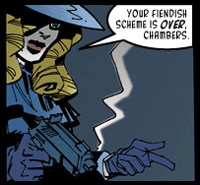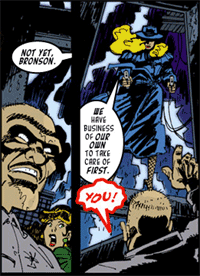This is a REview of Femme Noir. Comixpedia first reviewed Christopher Mill's webcomic Femme Noir in October 2003.
When I read the first strip in Femme Noir's latest storyline, I half expected the characters to begin saying "jeepers" and such things. I wasn't disappointed. Fortunately though, the offenders don't last very long.
Femme Noir, from the Supernatural Crime website, written by Christopher Mills and drawn by Joe Staton, is a solid and reliable strip (well, it would be reliable if they updated more often) for fans of the private eyes of old. Fans of E.C.'s horror stories won't be disappointed either, because Femme Noir is a blend of the two genres. Femme Noir features a mysterious blonde who lives in they mythical city of Port Nocturne, where she wanders the night, solving crimes and providing vigilante justice. The premise will be familiar to those who know the genre, although the supernatural overtones do introduce elements not normally found in a noir mystery. Many of the tales are lifted straight from early horror comic books, combining the two in a way that fits seamlessly. It seems natural for the protagonist to be fighting the supernatural just as much as it is natural for her to fight foreign spies. Despite this blend of two traditional genres, Femme Noir doesn't bring too much that's new to the table for neither genre, and combining the two wasn't enough to interest me.
 When I first saw the title "Femme Noir" I thought it would be an original webcomic, providing a new spin for the genre. I thought this because it has been dominated by flat two-dimensional male detectives, and I hoped that if Mills and Staton were going to change that with a female, perhaps they'd change even more. I should have paid more attention to the "Noir" in the title.
When I first saw the title "Femme Noir" I thought it would be an original webcomic, providing a new spin for the genre. I thought this because it has been dominated by flat two-dimensional male detectives, and I hoped that if Mills and Staton were going to change that with a female, perhaps they'd change even more. I should have paid more attention to the "Noir" in the title.
I must admit I didn't know too much about the genres Femme Noir fits before reading the webcomic, so I did a bit of research beforehand so I would be prepared to judge on how well Femme Noir matched up. I discovered that the stereotypical private-eye, who narrated everything in his head, had grown into a real person who actually had a background. I discovered that the genre had grown beyond the pulp magazine era and into the twenty-first century of storytelling. With that knowledge, I was expecting a character whom, while I might not like her, I could enjoy reading. However Femme Noir has much more in common with the private eyes of the old pulps than with the modern private eye. Femme Noir's nameless protagonist, known only as the blonde, who has no history or motives that are explored within the comic. However her character displays one minor change from her forbearers: the blonde isn't a private eye for hire. By returning to the two-dimensional characters of old, Mills has made a character that is difficult to like or to hate, or to form an opinion of one way or another. Leaving the audience not caring about a character who is supposed to carry the strip isn't a good move. For this reason, I don't think she makes a good main character.
Femme Noir fits the noir genre, obviously. Noir traditionally features archetypal characters, which definitely describes the characters of Femme Noir. Fortunately, the other characters in the strip are able to carry the stories better, being a bit more fleshed out. One recurring character who could definitely serve as a better protagonist is Rod Riley. He's the only honest cop in Port Nocturne, and he just becomes more archetypical the more I find out more about him. This isn't necessarily a bad thing, as Mills and Staton appear to have set out with Femme Noir to revisit everything that is old and familiar about horror and noir/mystery. But I feel they didn't need to rely quite so heavily on the trappings of the genre – that it would have been possible to have some originality with their characters. Unfortunately most of the other characters are only sparingly seen, with more information located in the character biographies than in the strip itself.
 The storylines are self-contained, with four Femme Noir comics published on the website so far, along with a few other stories set in Port Nocturne. Unfortunately, the stories are clichéd and familiar to anyone who has had a passing interest in the horror or mystery genres. From a creepy House of Horrors to a secret agent to a Frankenstein-like criminal to a missing priceless artifact, Femme Noir rehashes the old stories over and over again. Mills and Staton are able to do the old stories justice and they don’t resort to mocking themselves as many webcomics have. They're also able to provide the villains with motives (albeit clichéd ones) and you'll definitely be watching the villains when they're around. Despite this blending of two traditional genres, Femme Noir doesn't manage to progress beyond the tired, old storylines and well known tropes of both genres.
The storylines are self-contained, with four Femme Noir comics published on the website so far, along with a few other stories set in Port Nocturne. Unfortunately, the stories are clichéd and familiar to anyone who has had a passing interest in the horror or mystery genres. From a creepy House of Horrors to a secret agent to a Frankenstein-like criminal to a missing priceless artifact, Femme Noir rehashes the old stories over and over again. Mills and Staton are able to do the old stories justice and they don’t resort to mocking themselves as many webcomics have. They're also able to provide the villains with motives (albeit clichéd ones) and you'll definitely be watching the villains when they're around. Despite this blending of two traditional genres, Femme Noir doesn't manage to progress beyond the tired, old storylines and well known tropes of both genres.
One area where Femme Noir does shine is the art. Except for the black and white artwork in the first storyline which made the action difficult to discern, the strip contains wonderfully colored strips with well-drawn characters. Staying true to form, the artwork is as good as any mystery comic you could find on a news stand, and it helps ensnare the reader, pulling him into the story. One noticeable detail in the artwork is that the cars featured in the strip are from the period this webcomic is set. The comic is filled with tiny details like this, including the sound-effects and speech, working together to firmly place Femme Noir in early 20th century America. The artwork also works well at giving the comic an overall dark feel, with the lighting being used to good effect. Traditionally, noir comics and movies are in black and white, but the color in this webcomic is used well, and definitely doesn't detract from the feel of a noir piece, with the added advantage of being able to see what's going on.
I came into Femme Noir expecting a ground-breaking strip and I was fairly disappointed. Overall, Femme Noir is a solid webcomic that could easily have come from the 1930s. Die-hard fans of the pulp magazine era, who want to see all the familiar trappings and storylines in a webcomic format, need look no further. However for those who like a bit of originality in their webcomics, Femme Noir isn't for you.
John Lynch is a Comixpedia contributor.
I agree with Gary on this. Also, I think Chris and his crew do a great job by filling a genre that is sorely overlooked in the webcomics (and print comics) fields. People are always talking about the freedom of webcomics and the overuse of superheroes in print. So the webcomics gravitate toward other genres, and Chris is the founding member of the web noir stories. People should be giving his strips a look and aspire to professionalism that they witness.
I love Femme Noir. I think the review was a bit too harsh on Chris Mills’ writing. In my opinion Mills is an excellent modern writer that has learnt a lot (and is grounded by) the comics and pulp writers of the past, but he serves it up for the modern reader perfectly. The horror and crime market is one of the most popular (read commercial) genres on the bookstands — and the comics stands for that matter — and Mills is in his element with these sorts of stories that are produced without corporate editorial control. I seriously doubt this kind of quality would be seen back in the 30s. Mills has the gift of historical hindsight to do these stories right. Sure, they may not be for the young 15-20 year old reader (then again, maybe they ARE)… but Mills IS a writer that I can trust to deliver an entertaining story, every time.
I’m pretty sure Chris does the colouring and lettering on Femme Noir as well, which really adds to Joe Staton’s remarkable artwork.
Readers should give this strip a try. It deserves a wide audience, as does Mills’ other creations ‘Gravedigger’, ‘Knight and Gale’, ‘Perils on Planet X’ etc etc.
GC